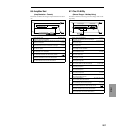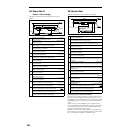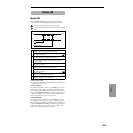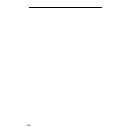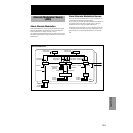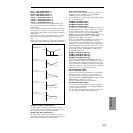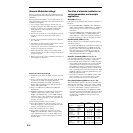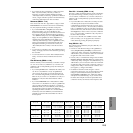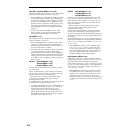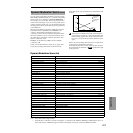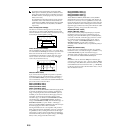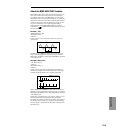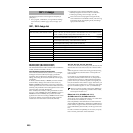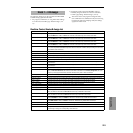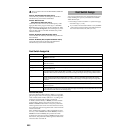
215
Appendices
• If you select the same controller for “AMS” and set the
Filter A (Low Pass Filter) “Intensity (A AMS 1/2
Intensity)” parameter and Filter B (High Pass Filter)
“Intensity (B AMS 1/2 Intensity)” parameter to different
values, a single controller operation will simultaneously
control the cutoff frequencies of the two filters.
Resonance (PROG 4.1–1b)
This can be used when the “Type (Filter1/2 Type)” is Low
Pass Resonance. The resonance level can be controlled by
EG, LFO, keyboard tracking, controllers or tempo etc.
• If you select Filter KT or Amp KT as the “Reso.AMS
(Resonance AMS),” you can use the filter or amp
keyboard tracking settings to control the resonance level.
For example if the amp keyboard tracking parameters
“Low (KBDTrk Ramp Low)” and “High (KBDTrk Ramp
High)” are set to positive (+) values, Amp KT +/+ is
selected as the “Reso.AMS (Resonance AMS),” and
“Intensity (AMS Intensity)” it set to a positive (+) value,
playing toward either end of the keyboard will cause
amp keyboard tracking to increase the volume, and
“Reso.AMS (Resonance AMS)” to raise the resonance
level.
• You can select a controller as the “Reso.AMS (Resonance
AMS),” and apply resonance when desired by operating
the controller.
• You can select LFO1 or 2 as the “Reso.AMS (Resonance
AMS),” and use the LFO to modulate the resonance
level.
Filter EG Intensity (PROG 4.1–2b)
Filter EG intensity can be controlled by a controller or tempo
etc. You can use “Int. to A (AMS Int. to A)” and “Int. to B
(AMS Int. to B)” to independently specify the intensity for
Filter A and B.
• If you select JS–Y#02 as the “AMS (Filter EG AMS)” and
set “Int. to A/B (AMS Int. to A/B)” to a positive (+)
value, moving the joystick, such as this instrument, in
the –Y direction will gradually increase the effect of the
Filter EG. If you set “Int. to A/B (AMS Int. to A/B)” to a
negative (–) value, the effect of the Filter EG will be
inverted.
• If you select Ribbon#16 as the “AMS (Filter EG AMS)”
and set “Int. to A/B (AMS Int. to A/B)” to a positive (+)
value, operating the ribbon controller on a connected
MIDI instrument, such as the TRITON, toward the right
will gradually increase the effect of the Filter EG.
Operating the ribbon controller on a connected MIDI
instrument, such as the TRITON, toward the left will
gradually increase the effect of the Filter EG with an
inverted phase.
Filter LFO 1/2 Intensity (PROG 4.1–4a)
The LFO 1/2 filter modulation intensity can be controlled by
EG, keyboard tracking, controller, or tempo. You can use
“Int. to A (LFO1/2 AMS Int. to A)” and “Int. to B (LFO1/2
AMS Int. to B)” to independently specify the intensity for
Filter A and B.
• If you select EG as the “AMS (LFO1/2 AMS),” the auto-
wah effect produced by LFO modulation will be
controlled by the changes in EG level. If you set “Int. to
A (LFO1/2 AMS Int. to A)”/“Int. to B (LFO1/2 AMS Int.
to B)” to a positive (+) value, the wah effect will deepen
as the EG level rises, and will lessen as the EG level falls.
With negative (–) values of “Int. to A (LFO1/2 AMS Int.
to A)”/“Int. to B (LFO1/2 AMS Int. to B),” the phase of
the LFO will be inverted.
• If you use a controller such as SW1 or 2 as the “AMS
(LFO1/2 AMS),” you can apply the auto-wah effect
when desired by pressing the [SW1] or [SW2] key.
Amp (PROG 5.1–2b)
The volume can be controlled by the pitch/filter EG, con-
trollers, or tempo etc.
• If an EG or controller that changes with a positive (+)
value (Amp EG, EXT(+), EXT(SW)) is selected as the
“AMS (Amp AMS),” setting the “Int (AMS Intensity)” to
+99 will allow you to increase the volume to a maximum
of eight times that of the current volume.
• If an EG, LFO, or controller that changes with a ± value
(Pitch EG, Filter EG, LFO, KT, EXT(+–) is selected as the
“AMS (Amp AMS),” setting the “Int (AMS Intensity)” to
+99 will allow you to increase the volume to a maximum
of eight times that of the current volume (for positive (+)
changes of the AMS), or to decrease the volume to zero
(for negative (–) changes of the AMS).
• In addition to the time-variant changes in volume
produced by the amp EG, you can also make the volume
change in synchronization with the pitch/filter EG.
Select PitchEG or FilterEG as the “AMS (Amp AMS),”
and adjust “Int (AMS Intensity).” If you wish to cancel
the effect of the AmpEG and use the pitch/filter EG to
control the volume, set all levels of the AmpEG to +99.
LFO1/2
–99...0...+99
KT(Flt KT, Amp KT)
–99...0...+99
KT(Note No.) *1
...36(C2)...60(C4)...84(C6)
...
JS X/Ribbon#16
–Max...0...+Max
EXT(+) *2
0...127
EXT(+–) *3
–Max...0...+Max
EXT(Tempo) *4
( ) = ...60...120...240...
dedicated parameter
–
–
–1...0...+1[Octave]
–1...0...+1[Octave]
–1...0...+1[Octave]
dedicated parameter
...–1...0...+1...[Octave]
...–1...0...+1...[Octave]
–1...0...+1[Octave] *5
–1...0...+1[Octave]
–1...0...+1[Octave]
0...+1[Octave]
0...+1[Octave]
0...+1[Octave]
–1...0...+1[Octave]
–1...0...+1[Octave]
–1...0...+1[Octave]
...–1...0...+1...[Octave]
...–1...0...+1...[Octave]
...–1...0...+1...[Octave]
dedicated parameter
–99x2...0...+99x2
–
–
–
–99...0...+99
–
–99...0...+99
–
...–99...0...+99...
–
...–99...0...+99...
–99...0...+99
–99...0...+99
–99...0...+99
–99...0...+99
0...+99
0...+99
0...+99
0...+99
–99...0...+99
–99...0...+99
–99...0...+99
–99...0...+99
...–99...0...+99...
...–99...0...+99...
...–99...0...+99...
...–99...0...+99...
dedicated parameter
–
–127...0...+127
–
–99...0...+99
–63...0...+63
–
...–99...0...+99...
...–63...0...+63...
value x(0...1...8)
–99...0...+99
–63...0...+63
value x(1...8)
0...+99
0...+63
value x(0...1...8)
–99...0...+99
–63...0...+63
value x(0...1...8...)
...–99...0...+99...
...–63...0...+63...
–
–
value x(1/128...1...128)
–99...0...+99
value x(1/64...1...64)
value x(1/64...1...64)
–99...0...+99
value x(...1/64...1...64...)
value x(...1/64...1...64...)
–99...0...+99
value x(1/64...1...64)
value x(1/64...1...64)
0...+99
value x(1...64)
value x(1...64)
–99...0...+99
value x(1/64...1...64)
value x(1/64...1...64)
–99...0...+99
value x(...1/64...1...64...)
value x(...1/64...1...64...) *8



